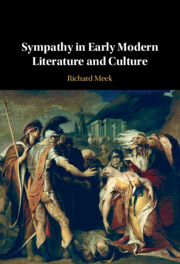Book contents
- Sympathy in Early Modern Literature and Culture
- Sympathy in Early Modern Literature and Culture
- Copyright page
- Contents
- Figures
- Acknowledgements
- Note on Texts
- Introduction
- Chapter 1 ‘A sympathy of affections’
- Chapter 2 ‘Compassion and mercie draw teares from the godlyfull often’
- Chapter 3 ‘Grief best is pleased with grief’s society’
- Chapter 4 ‘O, what a sympathy of woe is this’
- Chapter 5 ‘Soveraignes have a sympathie with subjects’
- Chapter 6 ‘As God loves Sympathy, God loves Symphony’
- Coda
- Bibliography
- Index
Chapter 4 - ‘O, what a sympathy of woe is this’
Passionate Sympathy in Late Elizabethan Drama
Published online by Cambridge University Press: 27 April 2023
- Sympathy in Early Modern Literature and Culture
- Sympathy in Early Modern Literature and Culture
- Copyright page
- Contents
- Figures
- Acknowledgements
- Note on Texts
- Introduction
- Chapter 1 ‘A sympathy of affections’
- Chapter 2 ‘Compassion and mercie draw teares from the godlyfull often’
- Chapter 3 ‘Grief best is pleased with grief’s society’
- Chapter 4 ‘O, what a sympathy of woe is this’
- Chapter 5 ‘Soveraignes have a sympathie with subjects’
- Chapter 6 ‘As God loves Sympathy, God loves Symphony’
- Coda
- Bibliography
- Index
Summary
This chapter explores how early modern dramatists were often preoccupied with ideas of pity and compassion, and sought out new words and metaphors for articulating such feelings. It begins by considering Marlowe’s Dido, Queen of Carthage (c. 1585-6) and Kyd’s The Spanish Tragedy (c. 1587), arguing that these plays centralize ideas of emotional comparability, receptivity, and resistance that fed into the subsequent emergence of the term sympathy. It goes on to examine Shakespeare’s Titus Andronicus (c. 1594), which contains an important early example of the word sympathy being used to describe a harmony of woe. The chapter then explores the emergence of the verbal form sympathize in several plays from the late 1590s, including The Comedy of Errors and Troilus and Cressida. It concludes with a discussion of Samuel Brandon’s 1598 closet drama The Vertuous Octavia, in which the protagonist invokes the possibility that she might ‘simpathize’ with her husband, while simultaneously suggesting that she is capable of resisting such emotional forces. This new word reflected and enabled a more active conception of sympathy as a practice of individual choice and agency.
Keywords
- Type
- Chapter
- Information
- Sympathy in Early Modern Literature and Culture , pp. 139 - 175Publisher: Cambridge University PressPrint publication year: 2023



